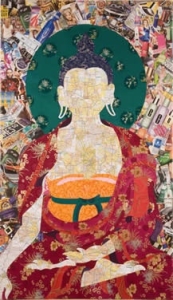Tibetan Contemporary Art:
From the Collection of Shelley and Donald Rubin
January 11 – February 22, 2009
 Contemporary Tibetan Art from the Shelley and Donald Rubin Collection introduces viewers to the diversity of contemporary Tibetan life inside China and abroad through artists’ considerations of the roles of Buddhism, art and heritage in their lives today. This exhibition illustrates the major themes in Tibetan art circles since 2000. The turn of the millennium brought introspection and we can see that a self-reflective turn began to replace outsiders’ ready-made fantasies of Shangri-la.
Contemporary Tibetan Art from the Shelley and Donald Rubin Collection introduces viewers to the diversity of contemporary Tibetan life inside China and abroad through artists’ considerations of the roles of Buddhism, art and heritage in their lives today. This exhibition illustrates the major themes in Tibetan art circles since 2000. The turn of the millennium brought introspection and we can see that a self-reflective turn began to replace outsiders’ ready-made fantasies of Shangri-la.
The works are multivalent, but offer four distinct lenses through which to view Tibet from new angles: continuity and affirmation of Buddhist arts and teachings; adaptation and re-invention of Buddhist imagery and art history for contemporary expressions; the passage of time and cultural sustainability; and secular modern life.
In both the Skylight and South galleries the continuity of Buddhist influence is a strong presence. The traditional Buddhist arts are, in today’ Himalayan cultures, certainly sustained as religious practices dictate, and Mukti Singh Thapa offers an exquisite example of the Newari lineage of thangka and mural painting which has influenced the region since the 8th century. Thangka painters continue to fill institutional and private commissions for religious usage, from merit- making to meditation or ritual aide.
Tibetan Buddhist thought offers compelling ideas and diagnoses of the human condition that may retain relevance to today’s society. Some (i.e. Pewang, Jhamsang) explore this through personal expressions grounded in deep knowledge of the Tibetan art historical tradition. Several artists reaffirm Buddhism’s core messages and practices without relying upon canonical imagery to represent those concepts and instead inventing their own imagery. This exhibition, in the South Gallery, features two reincarnate lamas whose art expresses spiritual realization and inspiration (i.e. Drugu Choegyal Rinpoche, Tai Situ Rinpoche). Other lay artists celebrate the Buddha’s enlightenment, pilgrims’ rituals, and expressions of faith (i.e. Sherab Gyaltsen, Dedron, Shelka).
In the South Gallery, several artists work with memory, nostalgia, tradition and the struggle between loss and preservation. The passage of time is evident in the appearance of ruins, aged faces, disappearing distinctive regional dress, emphasis of historical sites, etc. but this pronounced concern manifests in both muted and vibrant colors, evoking a range of emotions from despair to optimism for the future. (i.e. Tsering Dorje, Shelka, Tsering Dhondrup, Ang Sang, Pemba’s Remote Scenery).
In the Skylight Gallery, the use of Buddhist imagery functions more broadly to comment upon contemporary, secularizing society. In adapting familiar imagery for personal expression of contemporary times, they question the role of Buddhism in society, offer critique of their society, signal their unique cultural location, and more. The Buddha form, or a classical composition such as the mandala, are re-invented and re-purposed (i.e. Gonkar Gyatso, Tanor, Tenzin Rigdol, Jhamsang, Gade, Tsewang Tashi).
The fourth theme, also most visible in the Skylight Gallery, is that of secular culture in a time of dramatic urbanization, modernization, Sinocization and globalization. What happens to Buddhas and people in these contexts? These works confront outsiders’ expectations, as well as assert their own modern identity politics. (Norbu Tsering, Tsering Nyandak, Tsewang Tashi, Gonkar Gyatso, Gade). Concurrently, the influence of such a long rich history of Buddhist arts exerts a strong aesthetic and environment for today’s artists, who may reference it without intending to serve traditional religious functions, but who acknowledge the power of a culturally shared visual language.
The two furthest walls of the exhibition space, the endpoints of the axis, embrace the collection as bookends that are the most extraordinary examples of the merging and interdependence of these four themes. (the two Tenzin Rigdol Buddha’s are centered on these two walls)
Today’s artists accomplish demystification of Tibet without sacrificing appreciation of natural beauty, Buddhist values and cultural practices. At the same time, however, they call our attention to a time of radical change wrought by the powerful forces of Chinese Communism, international diaspora, modernization and globalization. The artists in this exhibition have each worked to address these issues in the personal ways in which they synthesize traditional and local arts with international approaches, combinations which span the artistic process from subject to materials to creative process.
Many of the works here have only been previously seen in the privacy of artists’ studios with friends and colleagues, or at the member-run Gedun Choephel Artists’ Association Gallery in the Old Quarter of Lhasa. Other pieces have been exhibited and published previously, but never before exhibited in context with so many other Tibetan artists working worldwide today. Indeed, this exhibition celebrates several milestones in the development of the international movement of contemporary Tibetan art: the first exhibition of works from the largest private collection of contemporary Tibetan art in the United States, the largest exhibition and number of participating artists mounted yet, the second time artists from Lhasa and from diaspora communities have been shown together in the US, and the first time artwork from Lhasa can be seen in Atlanta or the southeast.
The support of collectors like the Rubins plays a vital role in sustaining artists and their vision of cultural survival. The Rubins early participation in the emergence of this movement has contributed to the confidence, material supplies, and enthusiasm required for growth. This investment in their personal and cultural strengthening has enabled artists to garner, within the space of a few short years, international attention in Art Fairs, leading publications, and to earn a livelihood as artists, all of which were fantastic dreams but a few years ago.

